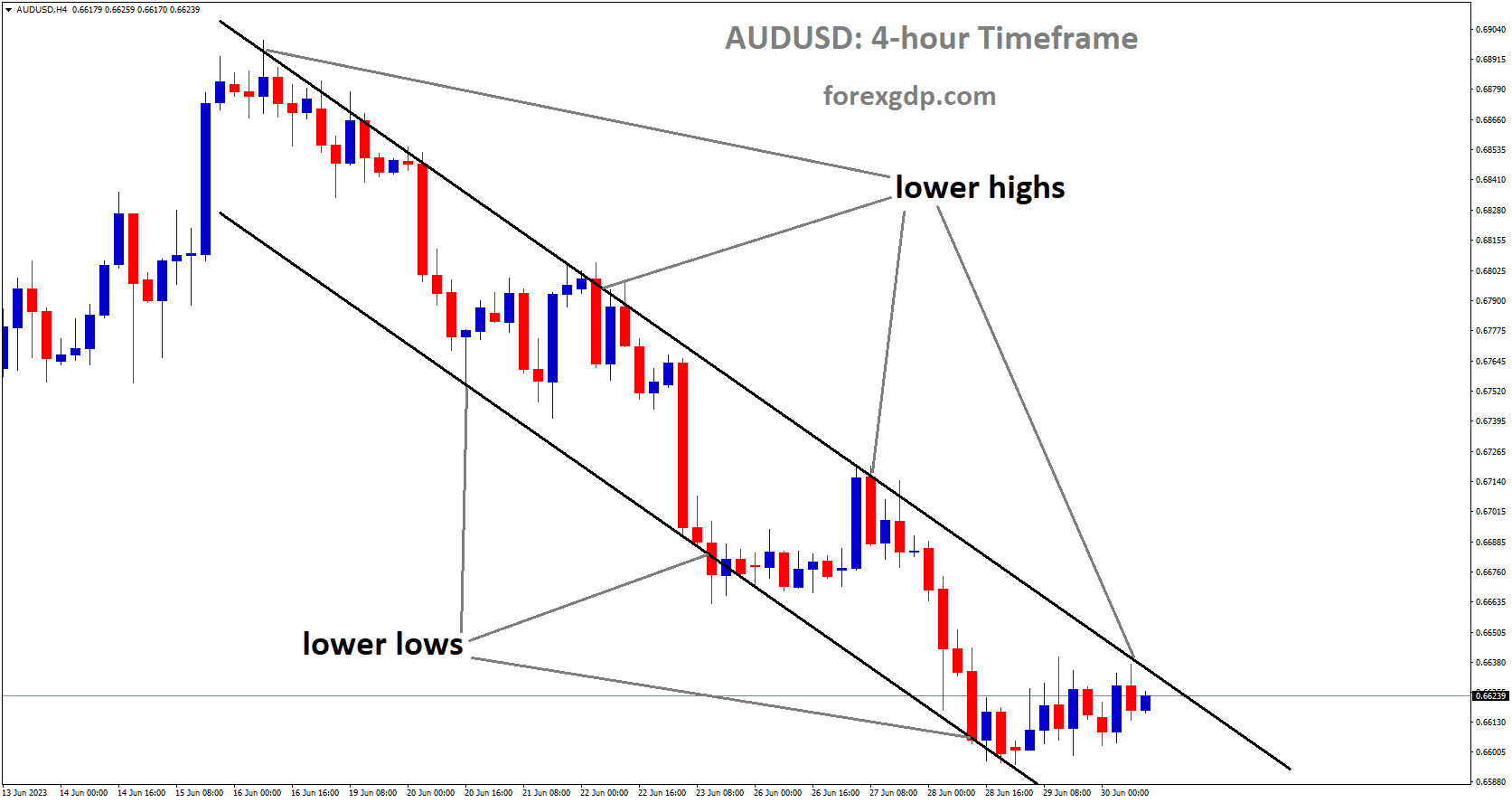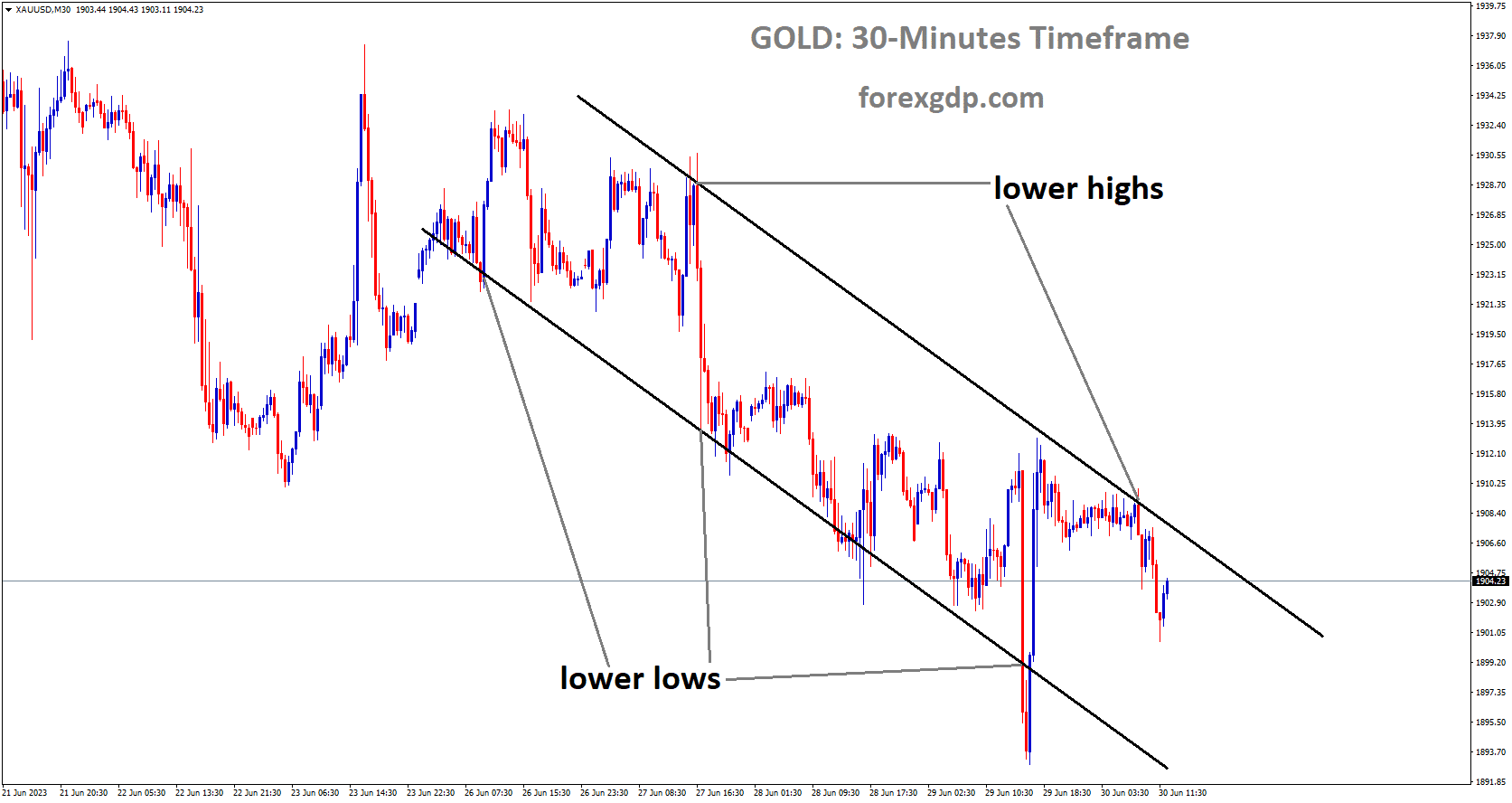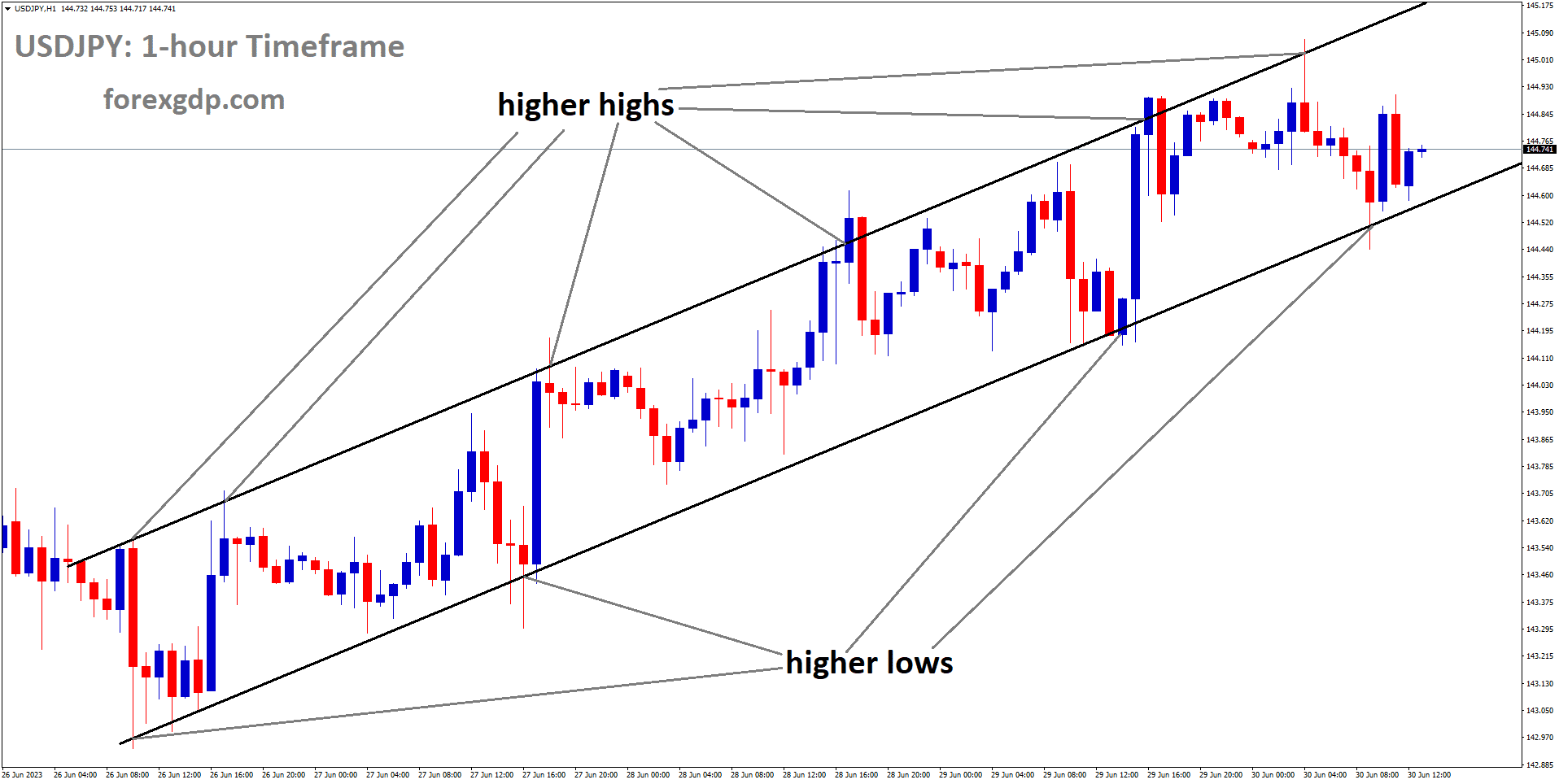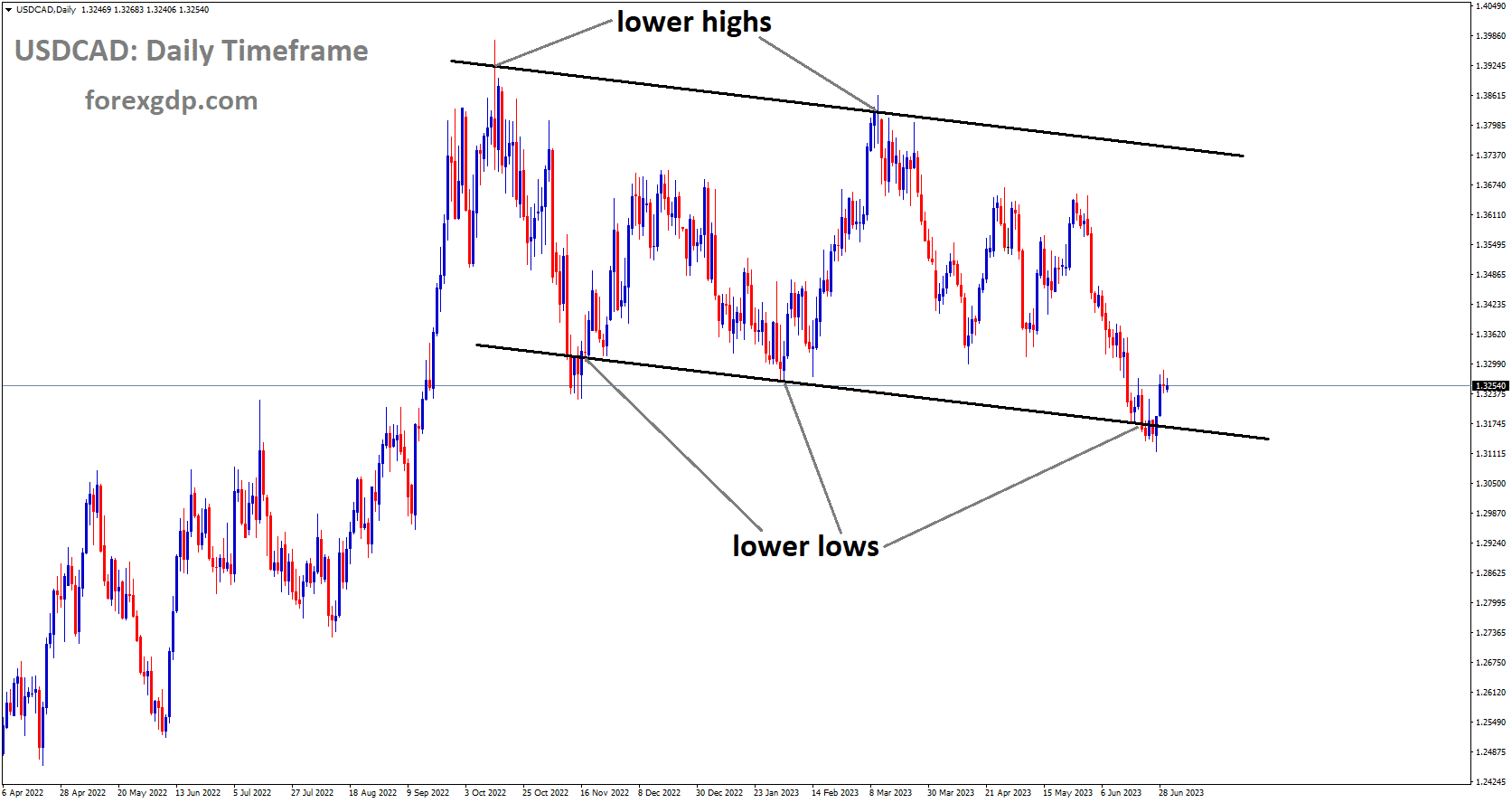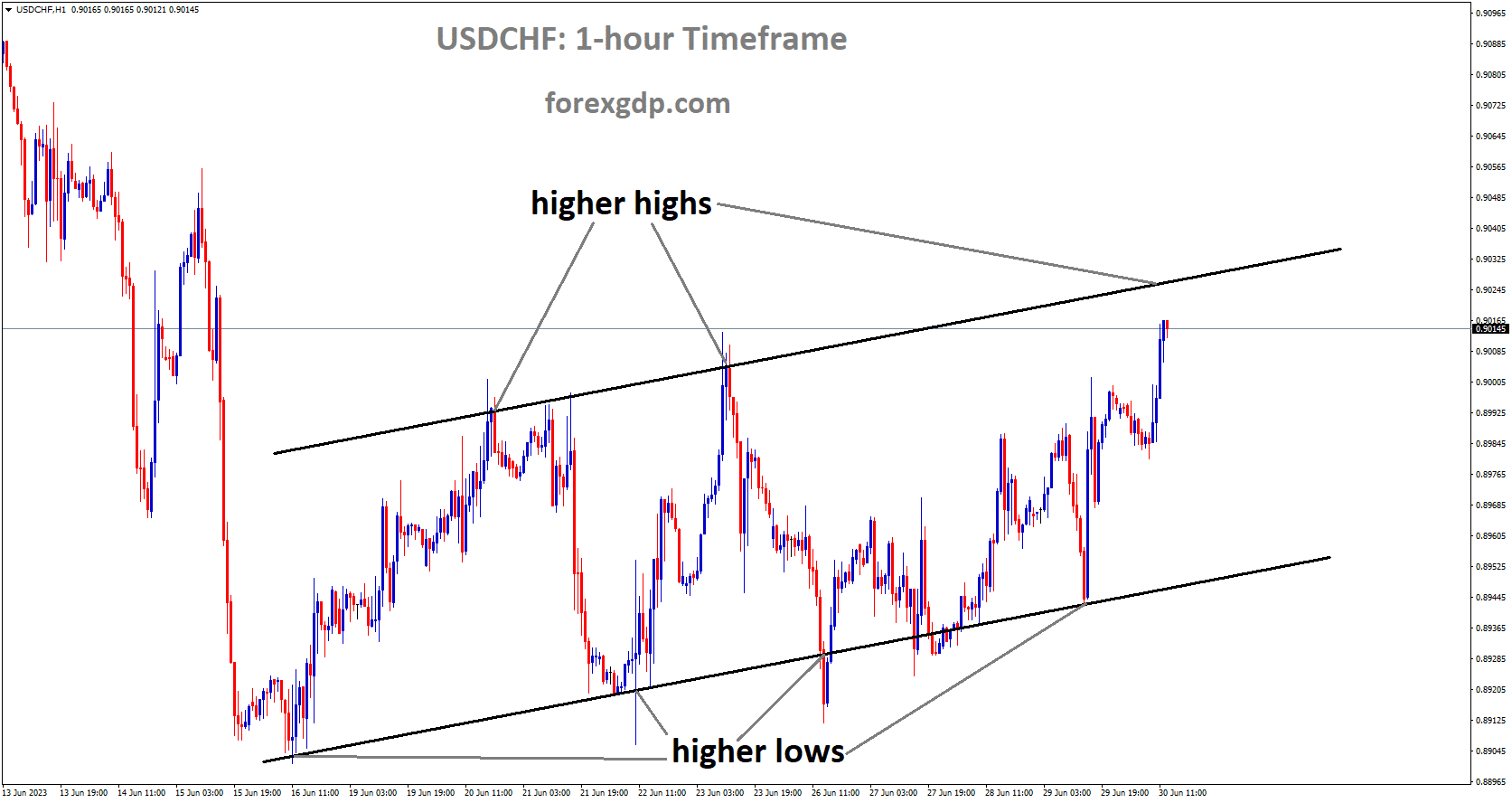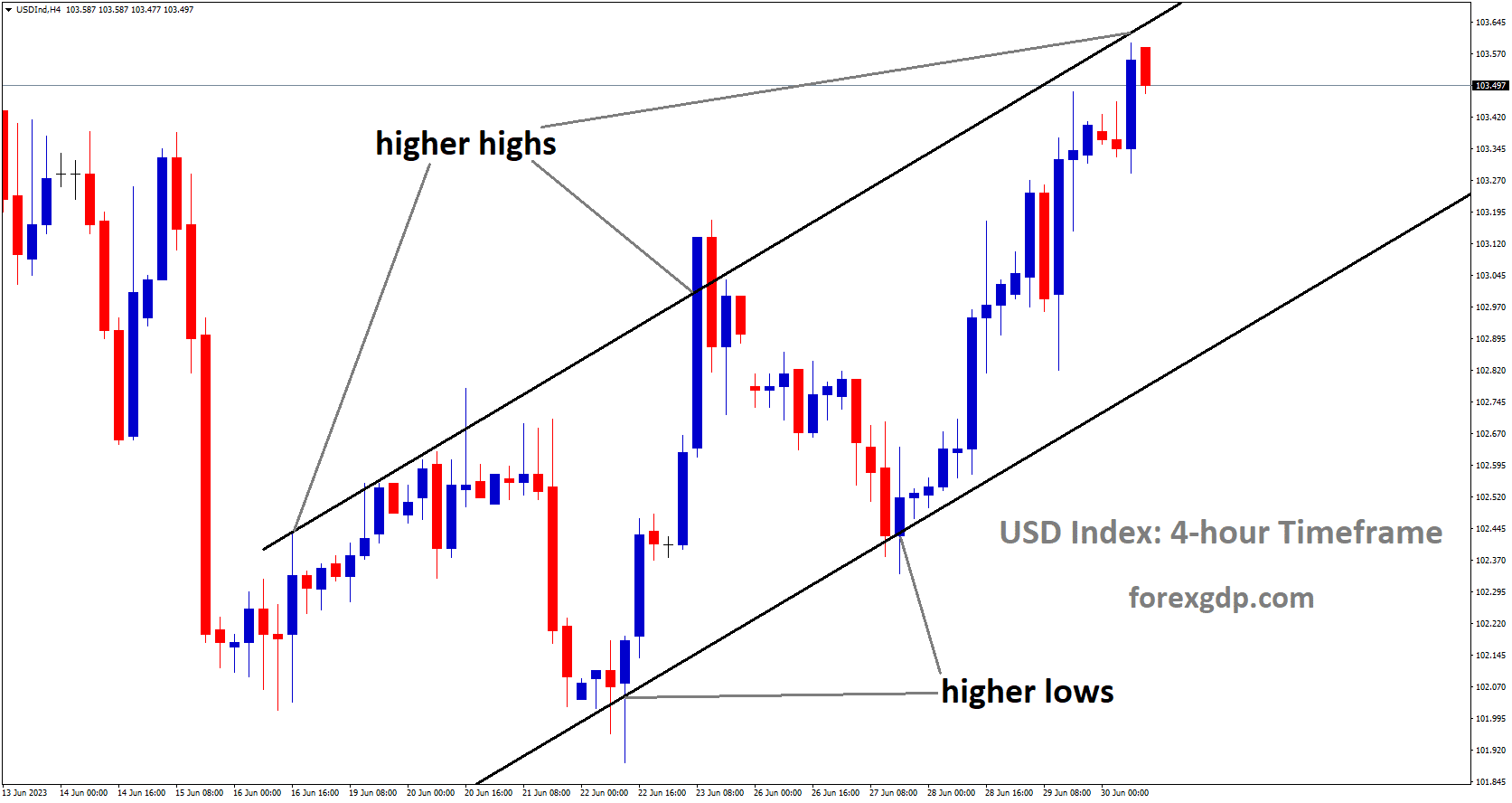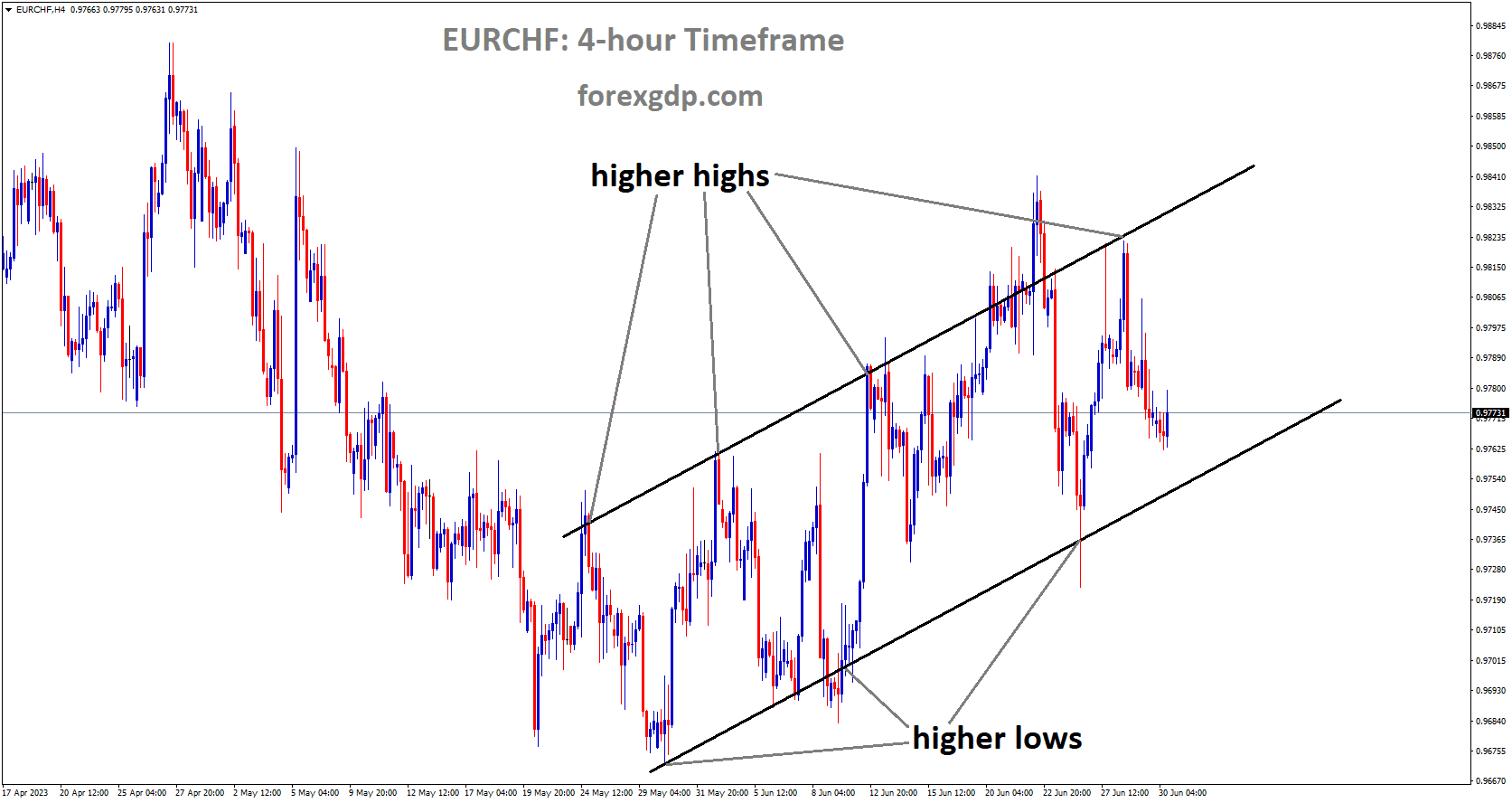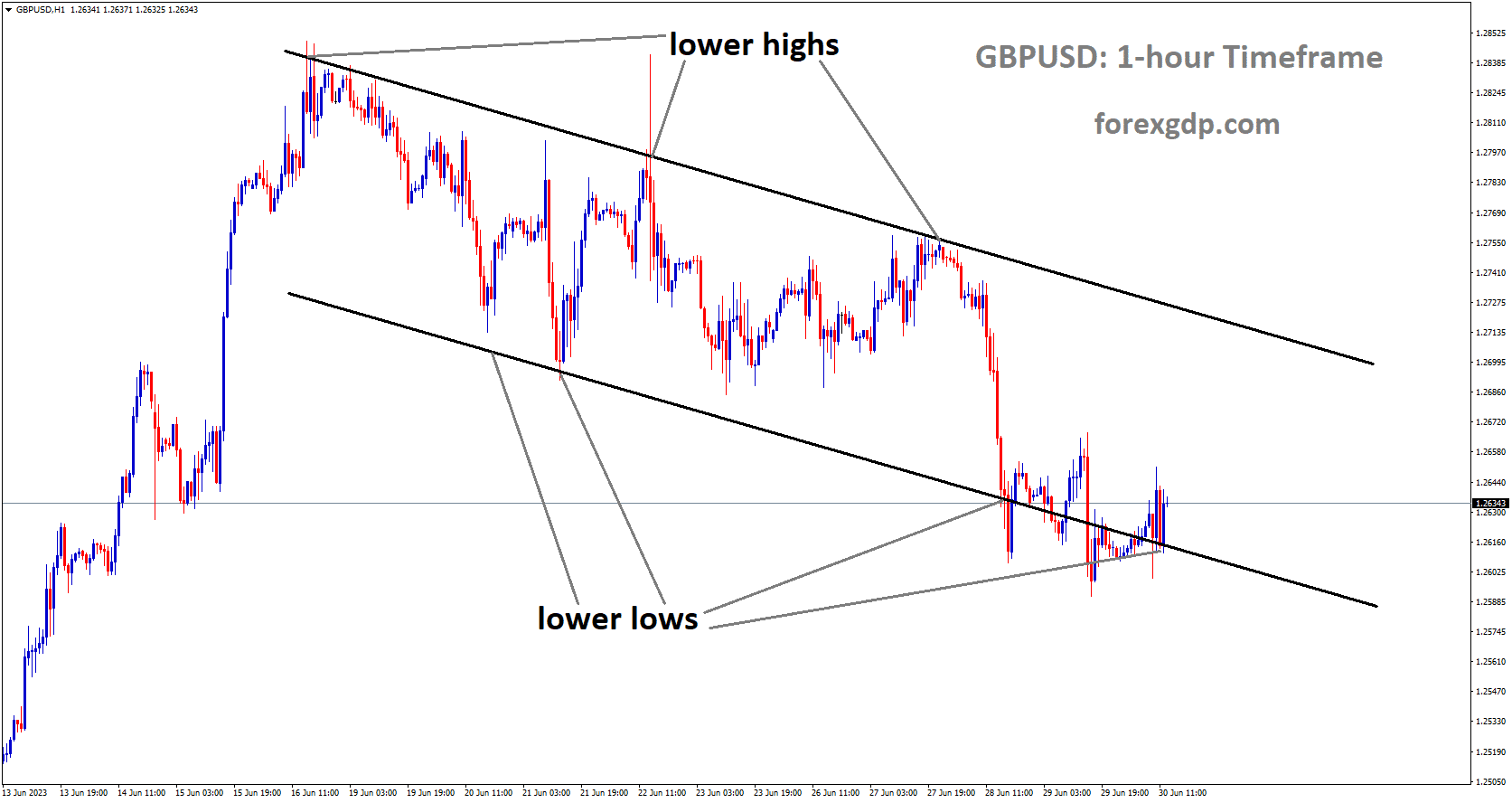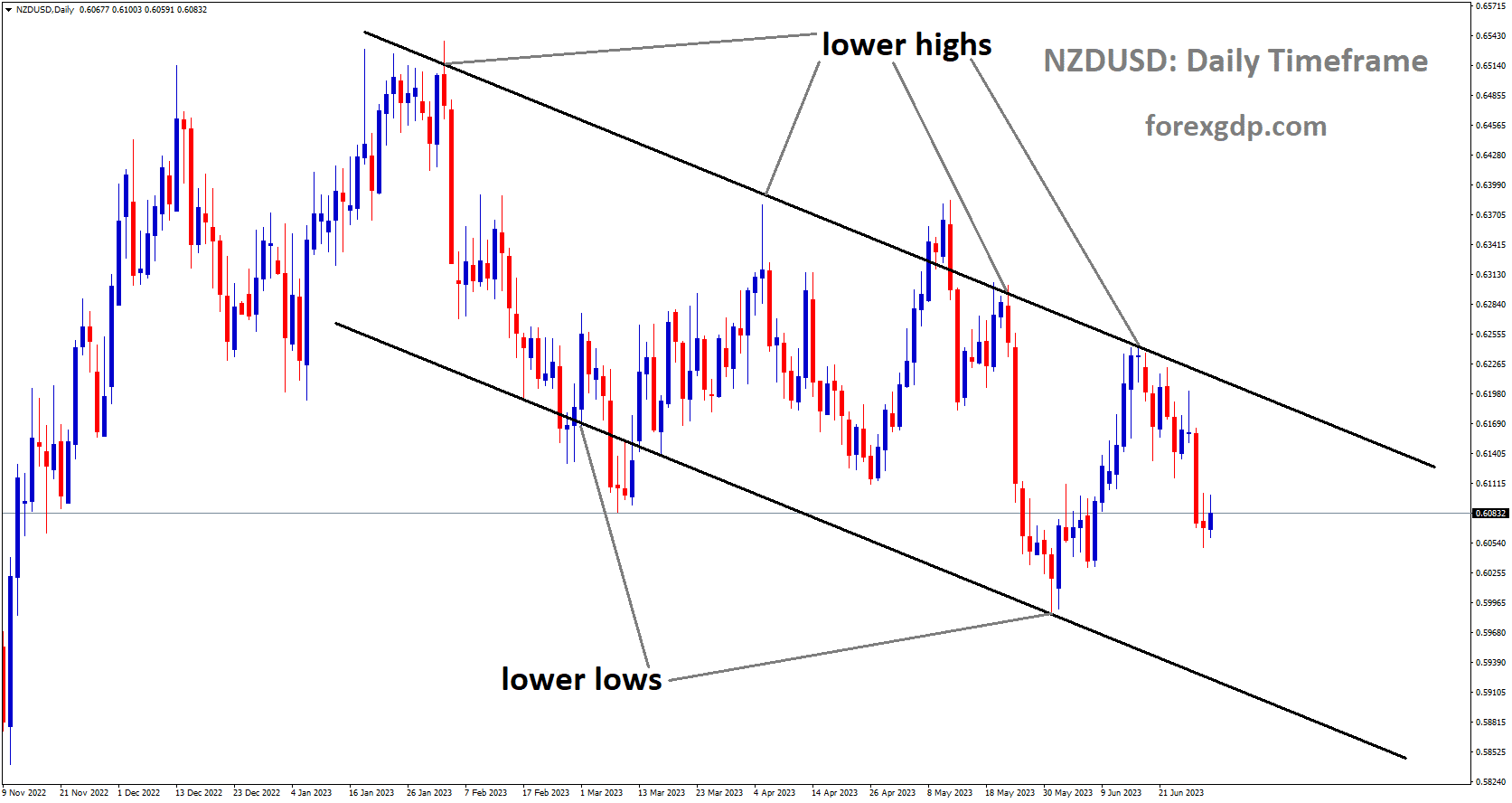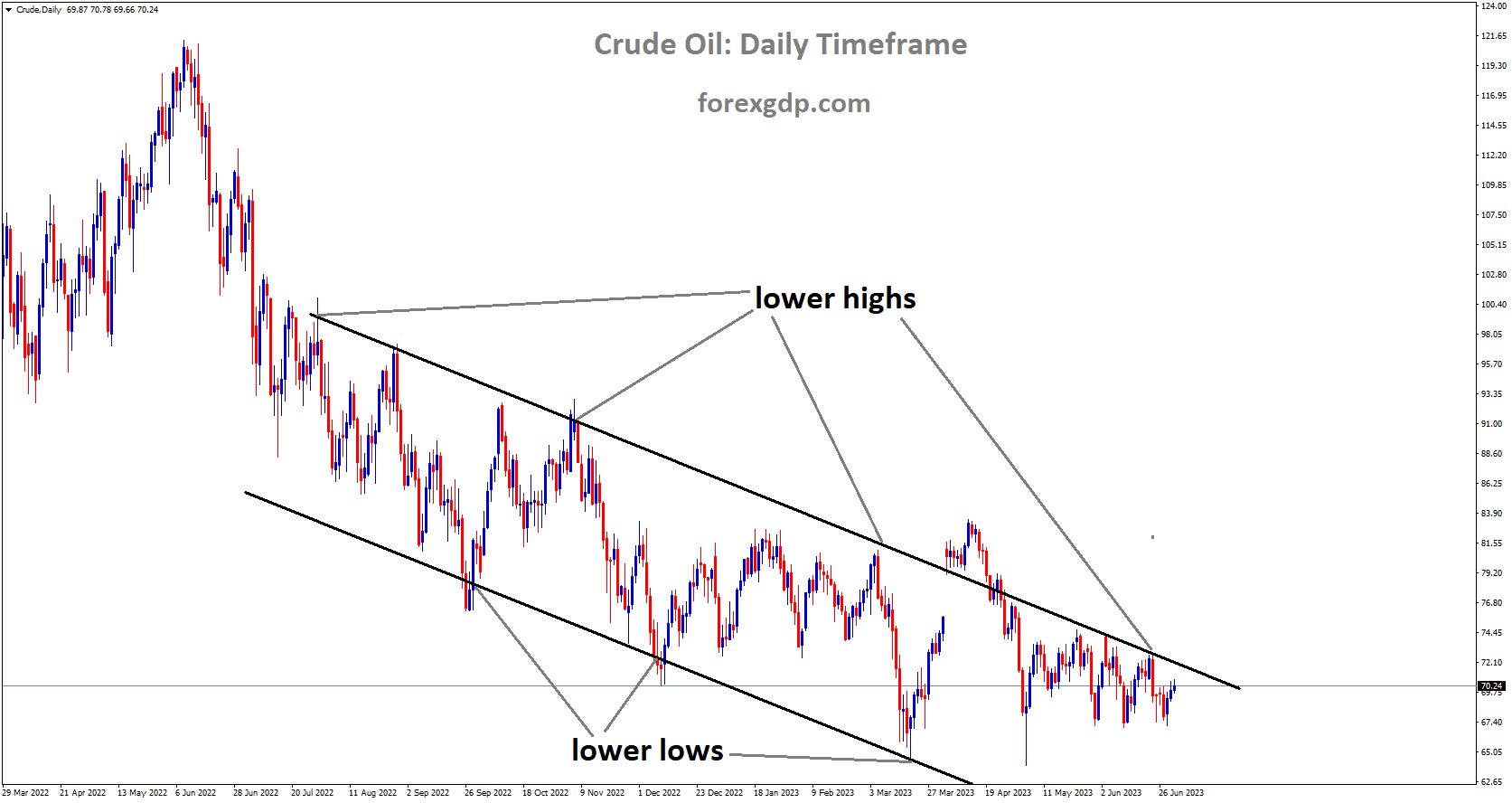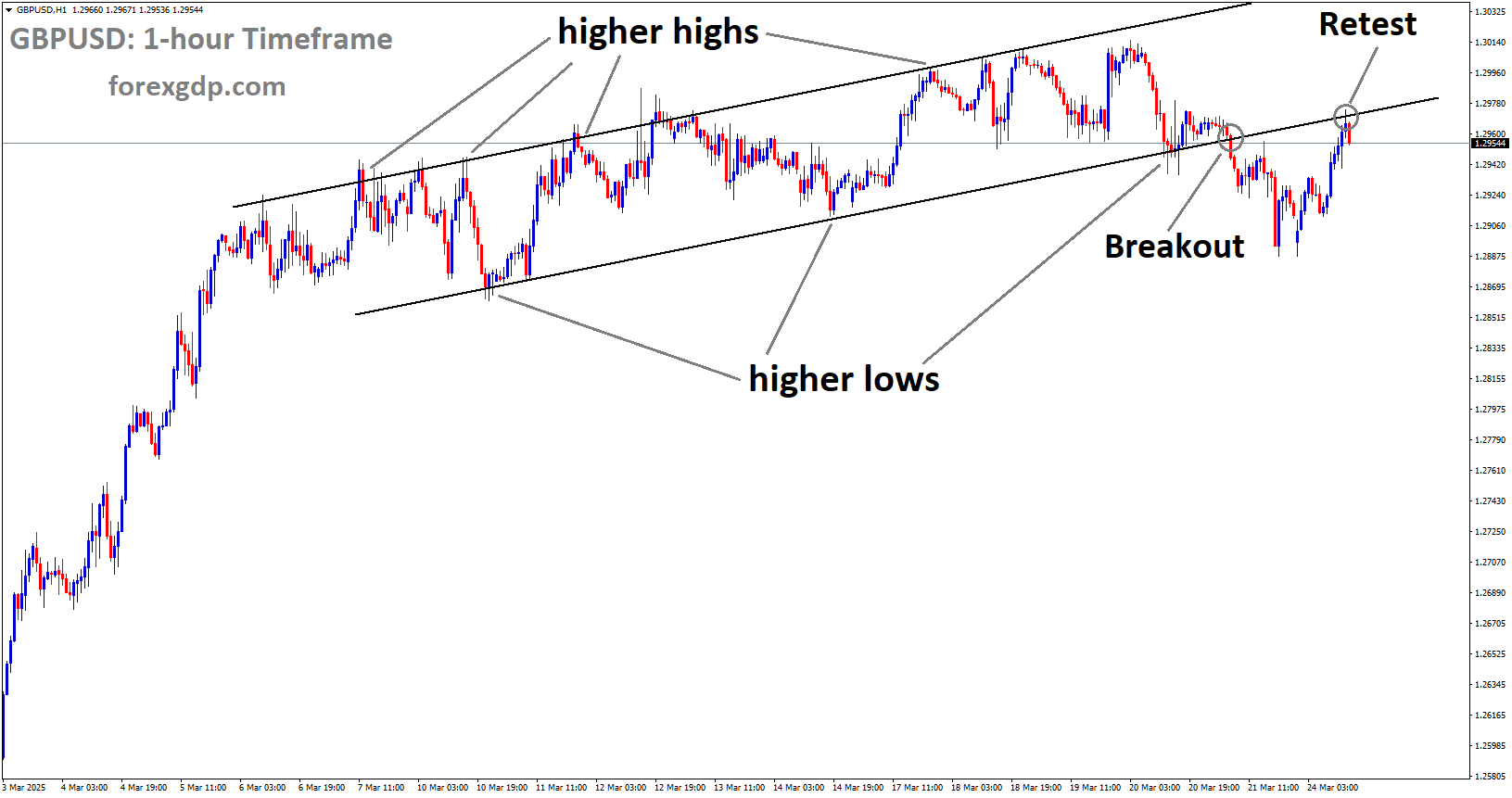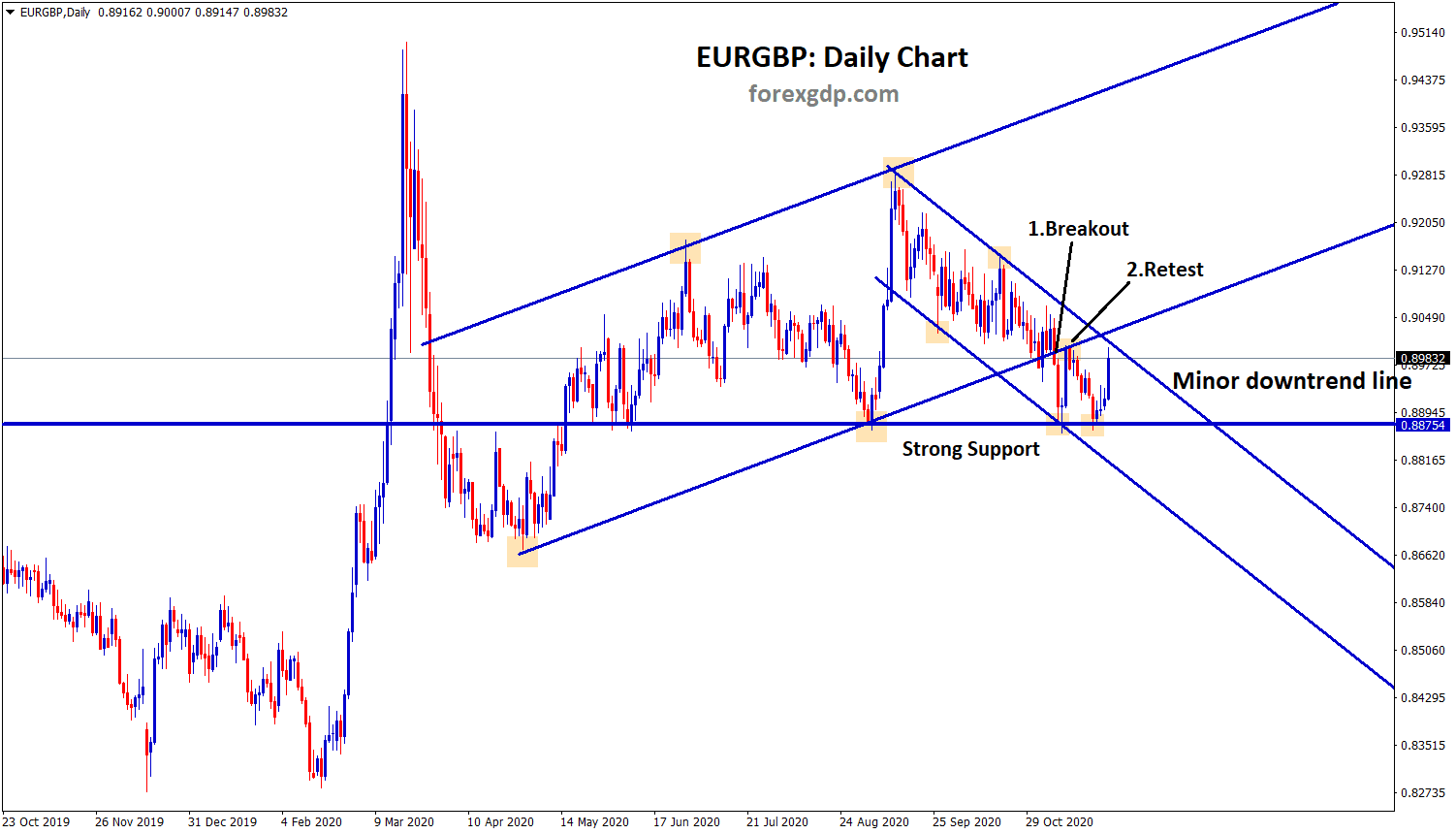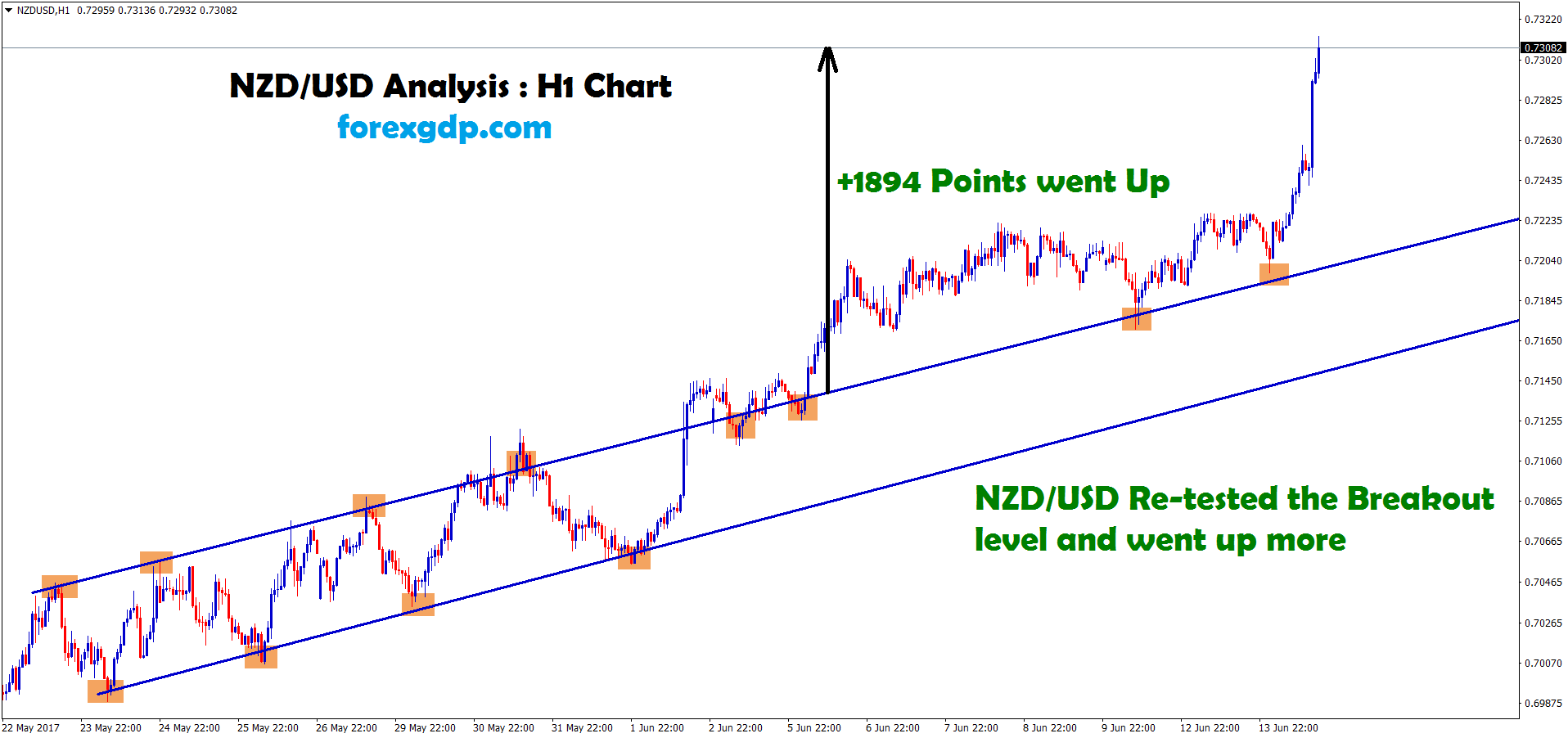AUDUSD Analysis
AUDUSD is moving in Descending channel and the market has reached lower high area of the channel.
Near the 0.6600 round-figure mark, the AUDUSD pair draws some intraday buying, but it is unable to take advantage of the trend and retreats a few pip from the daily high. Spot prices are currently trading in the range of 0.6620 to 0.6625, up less than 0.15% for the day, and are still quite close to the nearly four-week low reached on Thursday. Investors are still concerned about economic headwinds brought on by rapidly rising borrowing costs, and their concerns were made worse by the rather unimpressive macroeconomic data coming out of China. Although it increased slightly to 49 in June from 48.8 the previous month, the official Chinese Manufacturing PMI remained in contraction territory for the third consecutive month. Although it was lower than the 54.5 reading from May, the services sector indicator outperformed consensus expectations and registered a reading of 53.2 for the reported month. As a result, the Australian dollar, a proxy for China, is hampered and the AUDUSD pair is stabilised.
Expectations that the Reserve Bank of Australia will not raise interest rates in July further damage the Australian Dollar. The wagers were increased by softer domestic data, which showed that consumer inflation slowed to a 13-month low in May. This data was released on Wednesday. On the other hand, the US Dollar continues to be strongly supported by the Federal Reserve’s (Fed) hawkish outlook and stands tall near its highest level since June 13. The market’s expectations for a 25-bps lift-off at the upcoming FOMC meeting on July 25–26 were confirmed by this as well as the positive US macroeconomic data released on Thursday. The likelihood of further policy tightening by the US central bank continues to be favourable for an increase in US Treasury bond yields and to support the USD. However, it appears that market participants are hesitant to make large bets and would rather wait for the publication of the US PCE Price Index, which will have a significant impact on expectations regarding the Fed’s path for future rate hikes. This will then fuel USD demand and give the AUDUSD pair a fresh directional impetus. However, spot prices are still expected to post losses for a second straight week.
GOLD Analysis
XAUUSD is moving in Descending channel and the market has reached the lower high area of the channel.
Even as bears maintain control at the lowest levels in three months, the gold price lacks clear direction. Nevertheless, the metal’s most recent inaction may be explained by the prevailing cautiousness before important US inflation cues as well as by China’s mixed economic data. In addition, a lack of market activity during quarter-end positioning also appears to be constraining recent movements in the XAU/USD pair. The price of the yellow metal fell under the $1,900 mark, reversing the previous day’s 3.5-month low as US data increased the likelihood that the Fed will announce additional rate hikes. Both Fed Chair Jerome Powell and Atlanta Federal Reserve President Raphael Bostic made remarks along the same lines. It should be noted that the People’s Bank of China (PBoC) continued defence of the Yuan, despite significant costs, joins the China PMI readings below 50.0 to put downward pressure on the price of gold.
USDJPY Analysis
USDJPY is moving an Ascending channel and the market has reached higher low area of the channel.
The USDJPY pair stops its intraday retracement slide from its highest level since November 2022 reached this Friday near the 144.45 area. Spot prices are essentially unchanged for the day as they trade in the 144.55–144.60 region, and they appear ready to continue their recent, well-established uptrend that has been evident over the past three weeks or so. Investors were compelled to reduce their bullish bets surrounding the USD/JPY pair as a result of an intraday uptick beyond the 145.00 psychological level, which fueled rumours about a potential intervention by Japanese authorities. Furthermore, should the Japanese Yen (JPY) weaken too much, the government will take the proper action, according to Japan’s Finance Minister Shunichi Suzuki. This, along with the general atmosphere of caution in the market, gives the JPY some support while hindering the major. Investors are still concerned about economic headwinds brought on by rapidly rising borrowing costs, and their worries were made worse by the rather unimpressive macroeconomic data coming out of China. Although it increased slightly to 49 in June from 48.8 the previous month, the official Chinese Manufacturing PMI remained in contraction territory for the third consecutive month. Although it was lower than the 54.5 reading from May, the services sector indicator outperformed consensus expectations and registered a reading of 53.2 for the reported month.
In addition, the USDJPY pair is restrained by muted US Dollar price action, though any meaningful corrective slide is elusive in the wake of the Bank of Japan’s (BoJ) dovish stance. In fact, traders appear to be confident that the BoJ will maintain its negative interest rate policy at least through the following year. Furthermore, BoJ Governor Kazuo Ueda recently ruled out the possibility of any modification to the ultra-loose policy framework and hinted that no immediate plans to change the yield curve control measures are being made. This represents a significant departure from the Federal Reserve’s (Fed) hawkish outlook, which indicates that interest rates may still need to increase by as much as 50 basis points by the end of this year. Additionally, the positive US macroeconomic data released on Thursday all but guaranteed a 25 basis point rate increase at the July FOMC meeting. As a result, the yield on US Treasury bonds rises, favouring USD bulls and raising the likelihood of further gains for the USDJPY pair. However, traders appear hesitant before the publication of the US PCE Price Index.
Market expectations regarding the trajectory of future rate hikes will be significantly influenced by the Fed’s preferred inflation measure, the Core PCE. Additionally, this should give the USDJPY pair some significant momentum later in the early North American session and aid investors in determining the near-term course of the US dollar. Spot prices, however, are still expected to post gains for a third straight week. Furthermore, the aforementioned fundamental context suggests that the upward path is the one with the least amount of resistance.
USDCAD Analysis
USDCAD is moving in Descending channel and the market has reached the lower low area of the channel.
Crude Oil prices continue to support the commodity-linked Loonie and consolidate the gains made over the previous two days. On the other hand, the US Dollar (USD) retreats from its highest level since June 13 and ends up being another factor working against the USD/CAD pair. Any significant upside for the black liquid is, however, constrained by worries that a global economic downturn will reduce fuel demand. In addition, the Federal Reserve’s hawkish outlook gives the dollar and the major some support. It is important to keep in mind that the Fed earlier this month gave a warning that by the end of this year, borrowing costs may still need to rise by as much as 50 basis points. Additionally, the positive US macroeconomic data released on Thursday provided the Fed with yet another justification for raising interest rates and confirmed market expectations for a 25 basis point increase at the July FOMC meeting. In addition, Fed Chair Jerome Powell reiterated earlier this week that two rate increases this year are likely and added that he does not expect inflation to fall to the Fed’s 2% target until 2025.
The US Core PCE Price Index, the Fed’s preferred inflation indicator, is therefore expected later during the early North American session and will continue to be the market’s main focus. Expectations regarding the trajectory of future rate hikes by the US central bank will be significantly influenced by the crucial data. This should then influence USD demand and determine the direction of the next leg of the USD/CAD pair’s directional move. Therefore, it will be wise to hold off on positioning for an extension of this week’s goodish rebound from the YTD low until there is strong follow-through buying.
USDCHF Analysis
USDCHF is moving an Ascending channel and the market has reached the higher high area of the channel.
Swiss Franc (CHF) pair may reflect the hawkish slant of Federal Reserve officials and Swiss National Bank (SNB) officials, not to mention positive US data. Despite the fact that there were no significant updates from Switzerland on Thursday, SNB Governing Board member Andrea Maechler’s hawkish speech on Wednesday prodded the USDCHF bulls at the weekly top. According to SNB’s Maechler, Swiss inflation is widespread and more enduring than anticipated. Conversely, Fed Chair Jerome Powell stated that “a strong majority of Fed policymakers expect two or more rate hikes by year’s end” while speaking at the Fourth Conference on Financial Stability, which was hosted by the Bank of Spain in Madrid. According to Reuters, Raphael Bostic, president of the Atlanta Federal Reserve, also told reporters that he does not feel as compelled to act as Chairman Jerome Powell does with regard to potential rate increases. But the policymaker recently reversed course and said, “I think it is unmistakably that inflation has fallen considerably.
It should be noted that the majority of the US data were positive, which benefited the USD/CHF bulls. The US Gross Domestic Product Annualised, commonly referred to as the Real GDP, increased at a rate of 2.0% for the first quarter (Q1) of 2023 as opposed to the initial estimate of 1.3% on Thursday. Furthermore, compared to the 265K expected and previously revised figure, US Weekly Initial Jobless Claims plunged to 239K for the week ending June 23. However, the Personal Consumption Expenditure Price for Q1 2023 decreased from 4.2% expected and prior to 4.1% QoQ, while the Pending Home Sales declined from 0.2% expected and -0.4% prior to 2.7% MoM for May. In the midst of these manoeuvres, Wall Street ended up with a positive closing price, but the yields on US 10-year and 2-year Treasury bonds also increased, and the US Dollar Index (DXY) refreshed its weekly top before falling to 103.40. The S&P500 Futures print modest gains by the time of press, it should be noted. Looking ahead to May’s reading of the US Core Personal Consumption Expenditure (PCE) Price Index, a favourite inflation indicator of the Federal Reserve (Fed). However, the US Core PCE Price Index is probably going to stay at its current levels of 0.4% MoM and 4.7% YoY, which could allow the Fed to maintain its hawkish stance and support the USDCHF.
USD Index Analysis
USD Index is moving an Ascending channel and the market has reached the higher high area of the channel.
The Bureau of Economic Analysis will release the Core Personal Consumption Expenditures Price Index report for May on Friday. This is the Federal Reserve’s preferred inflation indicator. May’s predicted annual increase for the PCE Price Index is 4.6%, which is slightly higher than the 4.4% increase seen in April. With a monthly increase of 0.4%, it is anticipated that the Core PCE Price Index, which excludes volatile food and energy prices, will remain constant at 4.7%. Following its policy meeting in June, the Federal Reserve (Fed) decided to maintain its target interest rate in the range of 5% to 5.25%. FOMC Chairman Jerome Powell clarified that the pause in rate hikes did not necessarily imply that they have reached the terminal rate during the post-meeting press conference. In fact, the updated Summary of Economic Projections, or “dot plot,” showed that the interest rate projection for the end of 2023 was raised from 5.1% to 5.6%, indicating two additional rate increases of 25 basis points this year. This week, Powell reaffirmed that a large majority of Fed policymakers anticipated two or more rate increases this year and said that robust labour market conditions would allow them to continue tightening the policy. Powell was speaking at a policy panel at the European Central Bank Forum on Central Banking.
The CME Group FedWatch Tool currently indicates that markets are pricing in a probability of more than 80% that the Fed will increase the interest rate by 25 basis points to 5.25%–5.5% in July. However, there is a lower than 30% chance that the policy rate will be in the 5.5%–5.75% range by December. A hot PCE inflation report could lead to the US dollar strengthening further, according to market positioning. Given that base effects do not skew the monthly Core PCE Price Index, investors are likely to pay close attention to it. A reading of 0.5% or higher should raise the probability of two additional 25 bps Fed rate hikes in the second half of 2023 and strengthen the USD. However, a weak reading of 0.2% or less should make it difficult for the US Dollar to hold its own against its competitors going into the weekend.
EURCHF Analysis
EURCHF is moving an Ascending channel and the market has reached higher low area of the channel.
Credit Suisse economists predict that the Swiss Franc will depreciate, pushing the EURCHF pair to 1.02 by the end of the third quarter. At its June meeting, the SNB increased its policy rates by 25 basis points, which was in line with economists’ consensus predictions but below the STIR market’s pricing. We see the SNB’s decision to raise rates as dovish and set 1.0200 as our target rate for the end of the third quarter for the EUR/CHF. The more cautious approach may be due to recent strength in the real Swiss TWI and worries about financial stability risks in the banking/mortgage sector. Our main defence is that the Swiss Franc could lose strength if rate differentials between the Franc and its major peers continue to widen. A resurgence of Swiss inflation and the ensuing hawkish SNB are the risk.
GBPUSD Analysis
GBPUSD is moving in Descending channel and the market has reached the lower low area of the channel.
Around 1.2620 on Friday morning in London, the GBPUSD reverses from its intraday high while paring its first daily gains in three. In doing so, the Pound Sterling fails to explain the underwhelming UK GDP figures while portraying a cautious attitude in anticipation of important US inflation cues. According to the most recent readings, the final estimates of the UK’s first quarter (Q1) 2023 GDP match the 0.1% QoQ and 0.2% YoY forecasts. As the sentiment index rose to a 13-month high in June, Lloyds Banking Group Plc released the positive findings of the UK business confidence survey earlier in the day. In the wake of a decline in May, optimism increased 9 percentage points to 37%, according to the Lloyds Business Barometer. According to Bloomberg, executives claimed to be more optimistic about both their own and general trading prospects. A rise in UK auto production also provides support for the GBPUSD price along the same lines. According to the Society of Motor Manufacturers and Traders, 79,046 vehicles left UK factories in total last month, up nearly 27% from the same period last year. According to Reuters, that is still 31.9% below the output levels for 2019.
Silvana Tenreyro, who oversees the Bank of England’s monetary policy, made the following statement late on Thursday via Reuters: “The more BoE hikes now, the sooner and faster the BoE will later need to cut rates. Her remarks ran counter to the hawkish Fed talks and caused the pound to drop once more to a multi-day low. Despite this, Fed Chair Jerome Powell argued for two more rate increases in 2023, while Raphael Bostic, president of the Atlanta Federal Reserve, gave off conflicting signals but maintained his overall hawkish stance.
Along with the Fed’s relatively more hawkish remarks, the positive US data casts doubt on the recent run-up in the GBPUSD pair. Nevertheless, the Real GDP, also referred to as the Gross Domestic Product Annualised, increased at a rate of 2.0% for the first quarter of 2023 as opposed to the initial estimate of 1.3%. Furthermore, compared to the 265K expected and previously revised figure, US Weekly Initial Jobless Claims plunged to 239K for the week ending June 23. While Pending Home Sales declined to -2.7% MoM for May, compared to 0.2% expected and -0.4% prior, the Personal Consumption Expenditure Price for Q1 2023 eased to 4.1% QoQ from 4.2% expected and prior. The GBPUSD pair traders are anticipating the US Core Personal Consumption Expenditure Price Index for May, also known as the Federal Reserve’s (Fed) preferred inflation gauge, after seeing how the market reacted initially to the UK data. The Fed may be able to maintain its hawkish stance and call in the GBPUSD bears if the key inflation indicator stays static at 0.4% MoM and 4.7% YoY.
NZDUSD Analysis
NZDUSD is moving in Descending channel and the market has fallen from lower high area of the channel.
As mixed data from China combines with positive economic signals at home to push further downside during early Friday, NZDUSD bears pause close to the multi-day low. The cautious atmosphere in advance of the important US inflation gauge is another obstacle for the Kiwi bears. Nevertheless, the Kiwi pair increases bids to 0.6075 as it records its first daily gain in four days, of at least 0.05% intraday. China’s headline NBS Manufacturing PMI for June came in at 49.0 versus 48.8 expectations, while the Non-Manufacturing PMI increased past 50.2 analyst expectations to 53.2 versus 54.5 prior readings. However, New Zealand’s ANZ-Roy Morgan Consumer Confidence for June increased to 85.5 from 79.2 in the previous report. Due to Auckland’s connections to Canberra, the early-week disappointment from Australia’s inflation data contrasts with the Pacific giant’s upbeat Retail Sales to also nudge the NZD/USD bears. Despite this, the US Dollar remains firmer due to hawkish Federal Reserve (Fed) comments and positive US data, which puts downward pressure on the Kiwi pair despite a light domestic calendar and concerns over the Reserve Bank of New Zealand’s pause in rate hikes.
During the week, Atlanta Federal Reserve President Raphael Bostic flashed mixed signals but maintained his overall hawkish stance, while Fed Chair Jerome Powell called for two additional rate increases in 2023. In terms of US data, the Real GDP, also referred to as the Gross Domestic Product Annualised, increased at a rate of 2.0% for the first quarter (Q1) of 2023 as opposed to the initial estimate of 1.3%. Furthermore, compared to the 265K expected and previously revised figure, US Weekly Initial Jobless Claims plunged to 239K for the week ending June 23. However, the Personal Consumption Expenditure Price for Q1 2023 decreased from 4.2% expected and prior to 4.1% QoQ, while the Pending Home Sales declined from 0.2% expected and -0.4% prior to 2.7% MoM for May. In the midst of these manoeuvres, the markets are still unsteady despite a positive day, which presents challenges for NZDUSD traders ahead of the Federal Reserve’s preferred inflation indicator, the US Core Personal Consumption Expenditure Price Index, for May.
Crude Oil Analysis
Crude oil is moving in Descending channel and the market has reached the lower high area of the channel.
WTI is still in the lead going into Friday’s European session for the third straight day. As a result, the black gold manages to hold onto modest gains around the $70.00 round figure amid conflicting catalysts and a cautious attitude ahead of today’s US inflation hints and the OPEC+ meeting of energy producers that will take place in Vienna the following week. Recently, China’s activity data have stabilised, which gives hope that the dragon country’s economy will perform better after the COVID-19 fiasco. With only a limited amount of support for the government’s plan for domestic growth, the recovery appears to be moving slowly, though. Additionally, as US-China tension rises, more filters for the energy demand from the world’s largest consumer of commodities are feared to be added. In addition, worries about higher rates from the major Western central banks and the European recession put downward pressure on the price of WTI crude oil.
However, the most recent geopolitical issues involving Russia and OPEC+’s willingness to stand by the supply cuts seem to give oil buyers reason for optimism. The market’s optimism about the world leader’s economic recovery was sparked by recently stronger US data, and headlines from Moody’s suggest that the US will not be impacted by China’s economic difficulties. As a result, the energy market looks uncertain ahead of the OPEC+ seminar and the US Core Personal Consumption Expenditure Price Index for May, which is also known as the Federal Reserve’s (Fed) preferred inflation gauge. However, the quarterly movements raise concerns as the black gold records its second straight quarter-over-quarter loss for the first time since 2019.
Don’t trade all the time, trade forex only at the confirmed trade setups.
Get Live Free Signals now: forexgdp.com/forex-signals/

